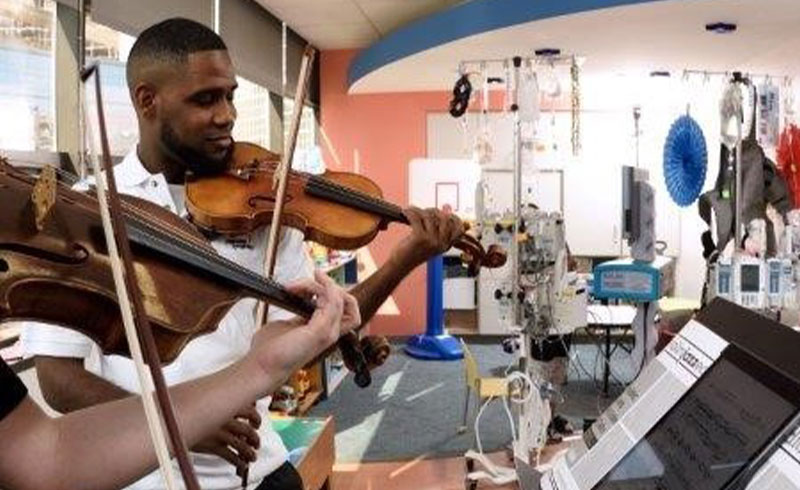
August 3, 2021
Cancer Survivorship Week and Music Therapy
In recent decades, a novel form of therapy is developing in the mental health profession, aimed at reducing stress and physical discomfort for patients. Music therapy focuses on providing a deeper connection to music via therapeutic and homeopathic means.
To better understand this phenomenal treatment, we sat down with music therapist Melissa Sandoval and Houston Symphony Community Embedded Musician Rainel Joubert, who work together at The University of Texas MD Anderson Cancer Center for music therapy sessions. Recently, Melissa and Rainel teamed up during MD Anderson’s Cancer Survivorship Week for a live music therapy Zoom event, “Playing in Harmony,” performing virtually to more than 25 guests.
Read more about Melissa and Rainel’s approach to music therapy, and their experience during Cancer Survivorship week below.
Houston Symphony: What goals does MD Anderson’s Cancer Survivorship Week seek to address?
Melissa Sandoval: Survivorship Week commemorates National Cancer Survivors Day, the first Sunday of June, to celebrate survivors, caregivers, families, and friends by providing sessions on education, resources, wellness, and more. MD Anderson acknowledges cancer survivors from the time of diagnosis through their life during and after treatment.
HS: Melissa, you’re a vocalist and guitarist—and an incredible musician yourself! Why does it help to also include Rainel in sessions like this and your work with patients?
MS: Though music therapists have extensive musical backgrounds and are musicians first and foremost, they are not experts on all instruments. Having a musician such as Rainel share his expertise on the violin provides more depth to the music programming we provide here. The goal of all musicians is to show the power that music holds in all settings, and this is no different for music therapists. We just want to ensure music is presented safely. Rainel has honed in on the beauty of instrumental music and brings that new perspective to our patients and families, something that is more difficult for music therapists to do if they are not classically trained on a string instrument.
HS: Rainel, what goes into the preparation for a music session? (emotional or musical) Is it hard to play such different genres back-to-back?

Rainel Joubert: To prepare, I have to make sure that there is enough emotional variety in the songs I pick. I normally build my menu in categories: Disney songs, challenging pieces, soothing works, and Pop hits. I also make sure that the quality of my performance is at my highest.
HS: Describe what you do during your sessions with the music therapist.
RJ: During the sessions, I wait for the music therapist to check on any particular need the patient may have before I am introduced. Once that’s assessed, the patients can pick any song from the music menu and I get to start playing!
HS: Melissa and Rainel, what was your hope for including this session within the Survivor Week activities?
MS: The collaboration between the Houston Symphony and music therapy allows the larger institution to gain insight into the innovative initiatives that Arts in Medicine provides within the Children’s Cancer Hospital. The goal of this particular session was to provide respite and allow the participants to actively or passively engage in music listening. There were no expectations on how they had to participate, but simply be present to hear music in the middle of their day.
RJ: Melissa and I wanted to make sure that everyone could escape through the music and have a good time while listening. We also thought we could connect with them more through some songs they could recognize. That’s why I choose to have a variety of songs on the menu.
Music will forever be a language understood by all, connecting people from all walks of life. With the help of music therapists like Melissa and Community Embedded Musicians like Rainel, music helps bring solace and togetherness to the people that need it the most. Read more about the Houston Symphony’s Music and Wellness initiatives here.






